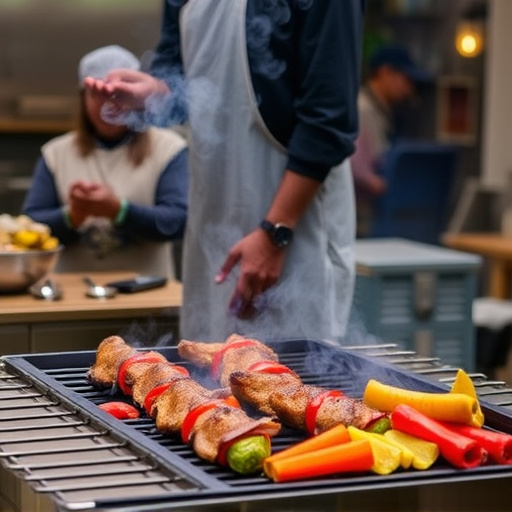Selecting the perfect BBQ pork tenderloin recipe starts with choosing a high-quality, well-marbled cut with even fat distribution for juicy, flavorful bites. Consider thickness and source locally for superior taste and texture. Proper storage and handling are crucial for maintaining freshness. Seasoning, dry-brining, marinating, and glazes enhance flavor and texture. The key to a perfect glaze lies in balancing protein and fat, using acids and sugars for complex flavors.
“Unleash the mouthwatering flavors of a juicy BBQ pork tenderloin – the perfect blend of tender, succulent meat and lip-smacking sauce. This comprehensive guide takes you on a journey from selecting the ideal cut to mastering the art of glaze creation and cooking techniques. Learn the science behind sealing in juices with the right BBQ sauce and discover a range of recipes catering to every taste preference. Whether you’re a grilling expert or a novice cook, master the art of crafting a perfect BBQ pork tenderloin recipe and indulge in a culinary experience that’s sure to impress.”
- Choosing the Right Pork Tenderloin
- – Selecting a high-quality tenderloin cut
- – Factors to consider while buying pork
- Preparation Techniques for Optimal Results
- – Trimming and seasoning the tenderloin
- – Marinades vs glazes: What works best?
- The Science Behind Juicy BBQ Sauces
- – Understanding protein and fat interactions
Choosing the Right Pork Tenderloin
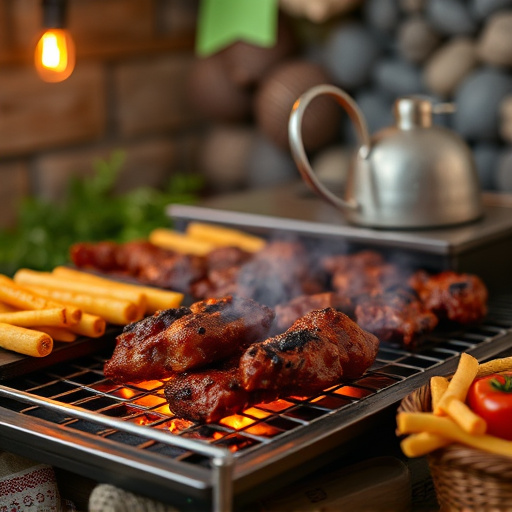
When it comes to selecting the perfect piece of meat for your BBQ pork tenderloin recipe, choosing the right cut is essential. Look for a tenderloin that is well-marbled with fat; this ensures that every bite is juicy and flavorful. The ideal size should accommodate your desired serving portions, allowing for even cooking without overcooking the exterior. Opt for a whole tenderloin if you plan to slice it yourself, as this offers more control over the thickness of each slice.
Consider the source and quality of the meat; locally sourced, free-range pork often provides a superior taste and texture. Freshness is key; ensure the tenderloin is stored properly and bought from a reputable supplier. Proper handling and storage are also crucial to maintaining the meat’s quality until cooking, guaranteeing a delicious BBQ pork tenderloin experience for your guests.
– Selecting a high-quality tenderloin cut
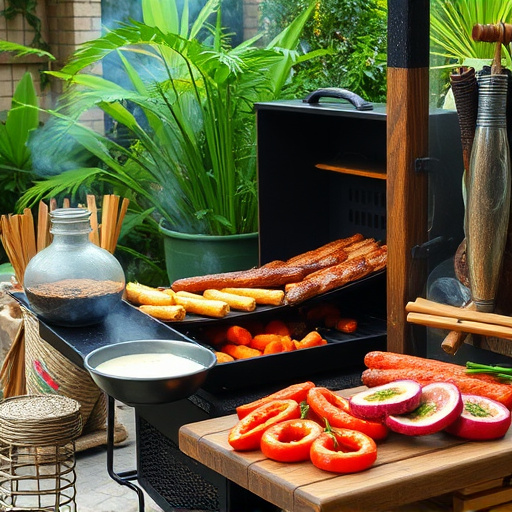
When preparing a BBQ pork tenderloin recipe, selecting the right cut is paramount. Opt for a high-quality, center-cut pork tenderloin to ensure even cooking and juicy results. This cut is known for its delicate flavor and tender texture, making it an ideal candidate for glazy, flavorful sauces like barbecue. Look for a tenderloin with a consistent thickness, as this will help the heat cook the meat evenly, resulting in a perfectly cooked pork tenderloin that’s both tender and moist.
For the best BBQ pork tenderloin recipe, consider choosing a tenderloin that’s at least 1-inch thick. This ensures that the interior stays juicy while the exterior sears beautifully. Properly selecting your cut is a crucial step that forms the foundation for a mouthwatering dish.
– Factors to consider while buying pork
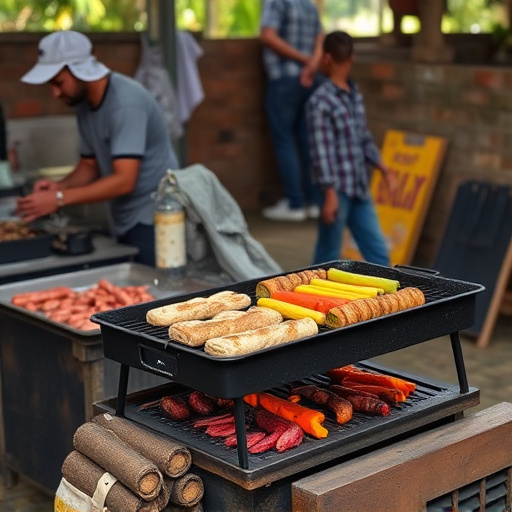
When sourcing pork for a mouthwatering BBQ pork tenderloin recipe, several key factors come into play. Look for high-quality, fresh cuts like center-cut loin or eye of the loin, which are known for their tenderness and minimal fat content. This ensures that your final dish is succulent and not overly greasy. Opting for grass-fed pork can also add a richer flavor profile to your BBQ sauce glazes.
Consider the thickness of the tenderloin as well—thicker cuts take longer to cook but result in more even doneness, while thinner cuts may require quicker cooking times. Additionally, marinating or dry-brining before cooking can significantly enhance the meat’s overall taste and texture.
Preparation Techniques for Optimal Results
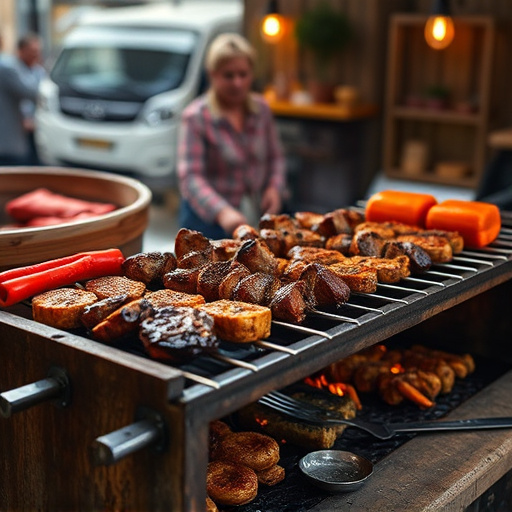
For optimal results with this mouthwatering BBQ pork tenderloin recipe, preparation is key. Start by ensuring your pork tenderloin is of the highest quality, choosing a lean cut for the best texture and flavor. Pat the meat dry with paper towels before seasoning; this step is crucial as it allows the seasoning to adhere better. A dry rub of salt, pepper, garlic powder, and paprika will add depth of flavor.
Before grilling, let the tenderloin come to room temperature, which ensures even cooking. Consider marinating the pork for an hour or two in your favorite BBQ sauce to infuse it with flavor; this technique is especially beneficial if you’re a fan of moist, tender meat. When ready to cook, preheat your grill to high heat, ensuring it’s nice and hot before placing the tenderloin on the grate. This will create those desirable grill marks and seal in the juices.
– Trimming and seasoning the tenderloin

Before glazing your mouthwatering BBQ pork tenderloin, it’s crucial to start with a well-prepared cut of meat. Begin by trimming any excess fat from the tenderloin, leaving a thin layer for flavor and moisture. This step ensures even cooking and prevents the sauce from burning. Once trimmed, season both sides generously with salt and pepper. You can also use a dry rub consisting of paprika, garlic powder, and onions powder for an extra smoky, flavorful kick—a favorite among BBQ enthusiasts in search of the perfect bbq pork tenderloin recipe.
– Marinades vs glazes: What works best?
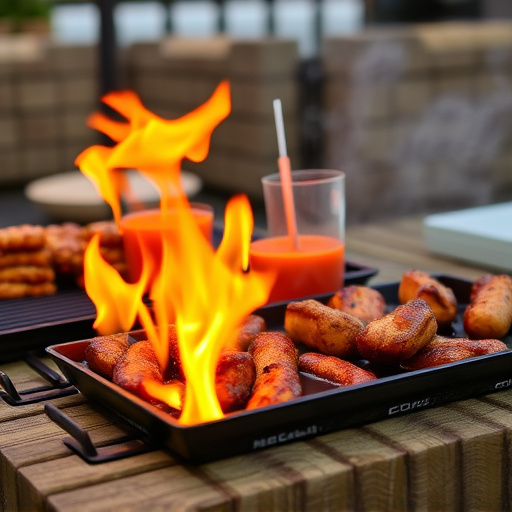
When it comes to enhancing the flavor of pork tenderloin in a BBQ sauce, marinades and glazes offer distinct approaches. Marinades are a time-honored method, involving soaking the meat in a mixture of spices, herbs, and liquids for an extended period, often overnight. This technique allows flavors to penetrate deeply into the meat, transforming its overall taste profile. For a BBQ pork tenderloin recipe, a marinade might include ingredients like garlic, ginger, soy sauce, and various spices, ensuring a rich, complex flavor.
Glazes, on the other hand, are applied as a topping during cooking, providing an instant burst of flavor. They are typically made from a combination of BBQ sauce, vinegar, brown sugar, or honey, and sometimes include additional ingredients like mustard or chili powder. Glazes create a sticky, caramelized crust on the surface of the pork tenderloin, offering both a delightful texture and a rich, savory taste. For those seeking a quicker preparation method, glazes are ideal, as they don’t require advance soaking and can be brushed on during grilling, adding a juicy, flavorful finish to your BBQ pork tenderloin recipe.
The Science Behind Juicy BBQ Sauces
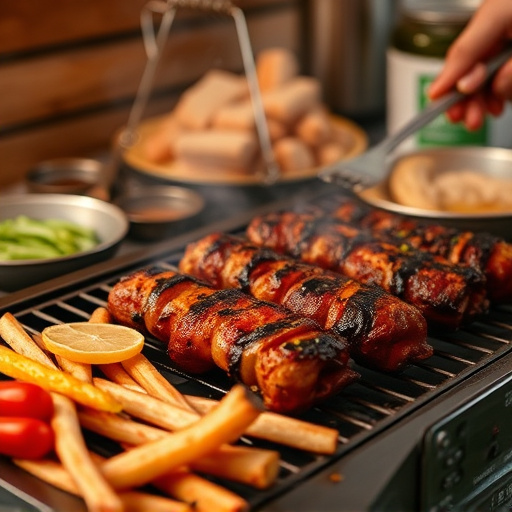
The juicy, glistening coat of barbecue sauce on a perfectly cooked pork tenderloin is more than just a delicious treat—it’s a culinary science experiment. The secret lies in the balance of sugars, acids, and spices that caramelize and penetrate the meat, transforming its texture and flavor. In a BBQ pork tenderloin recipe, these elements work together to create a sauce that both seals in juicy flavors from within the tenderloin and forms a crisp, sticky exterior.
Acidic ingredients like ketchup, vinegar, or citrus juice lower the meat’s surface temperature, slowing protein coagulation and allowing for better penetration of flavors. Sugars, such as brown sugar or honey, provide sweetness and contribute to the browning reaction, creating that desirable caramelized glaze. Spices—from paprika to cayenne pepper—add depth and complexity, enhancing both the sauce’s taste and its interaction with the meat’s natural juices during cooking. This precise interplay ensures a mouthwatering result, where each bite reveals a tender, juicy interior perfectly balanced by a savory, sticky exterior.
– Understanding protein and fat interactions
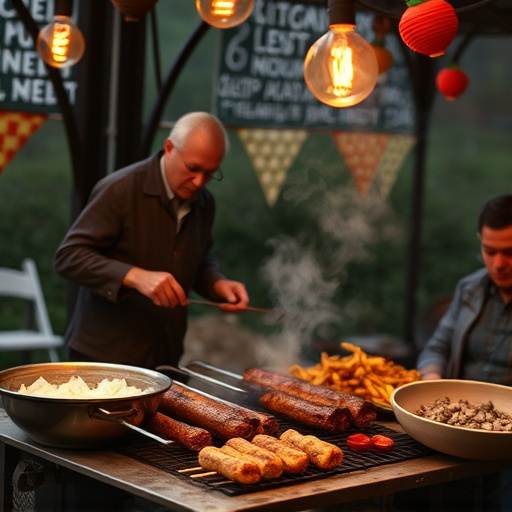
When crafting a mouthwatering BBQ pork tenderloin recipe, understanding the delicate balance between protein and fat is key to achieving the perfect glaze. Protein, primarily found in the meat, requires fat to create a juicy, tender final product. The right combination of these two elements ensures that your barbecue sauce glazes stick optimally, infusing every bite with rich flavor.
In a BBQ pork tenderloin recipe, fat acts as a binding agent, helping to set the sauce and prevent it from washing off during cooking. This is particularly crucial when using a glaze that contains sticky ingredients like honey or brown sugar, which can pull moisture away from the meat if not balanced properly with fat. By understanding this interaction, you can tailor your cooking method and sauce composition to achieve succulent, flavorful results every time.
